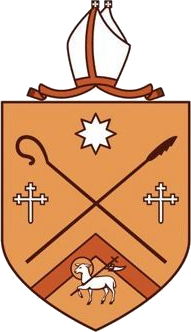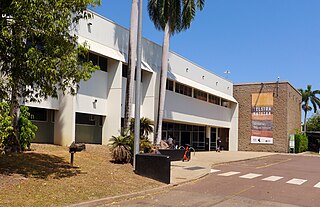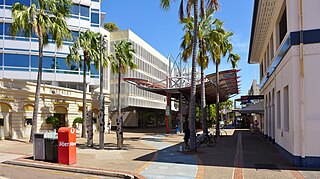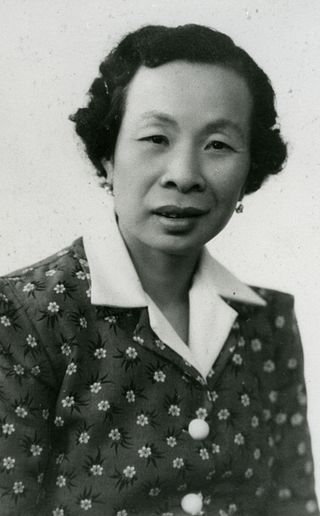
The Victoria Hotel, or The Vic as it is commonly known, is a heritage listed pub located in Darwin, Northern Territory, Australia. Built in 1890, it is an important historical building but is currently closed.

The Victoria Hotel, or The Vic as it is commonly known, is a heritage listed pub located in Darwin, Northern Territory, Australia. Built in 1890, it is an important historical building but is currently closed.

The Victoria Hotel was built by Ellen Ryan, one of the Territory's wealthiest women, who owned land and several mining leases. In 1888 Ryan moved into the Territory hotel trade, lodging a successful application with the licensing board for a prestigious hotel to be built at 27 Smith Street in central Darwin, then known as Palmerston, during the northern Australia gold rushes of the 1870s onwards. [1] [2] Constructed by H.C. Debross, it was built for £4,000 and was the first stone building in Darwin. [3] The two-storey hotel was made of local, multi-coloured porcellanite stone, with a facade dominated by a parapetted gable and verandahs. [4] Upon completion, the building dominated Smith Street and remained that way for over half a century. [5]
The hotel opened on 8 September 1890. It was first called The Royal Hotel but was renamed the North Australian Hotel a few days after opening. [6] It was renamed the Victoria Hotel in 1896. [3]

The Victoria Hotel lost part of its roof and was damaged internally during a cyclone on 6 January 1897. [7] Known as the "Great Hurricane", it killed 28 people, sank 19 vessels in the harbour including the entire pearling fleet, and caused around £150,000 damage (equivalent to £21,500,000in 2023) throughout the town. Structurally however, the hotel was one of only a few buildings that remained intact and it was repaired shortly afterwards. [8]
In 1908, the hotel accommodated Henry Dutton and Murray Aunger, the first motorists to cross the Australian continent from Adelaide to Darwin. [2]
In 1915, the hotel was one of several to be nationalised by Northern Territory Administrator, John Gilruth. [9] Known as the government take-over, the hotel was the focal point for political turmoil and union unrest between 1911 and 1919, which came to a head on 17 December 1918 in what was known as the Darwin Rebellion. [10]
Ross and Keith Smith and other aviators connected with the air race from England to Australia stayed at the hotel in December 1919. [5] [2]
Mining entrepreneur May Brown became the first publican win the lease on Darwin's Victoria Hotel in 1921 when the era of state control of Top End hotels came to an end. [11] Christina Gordon took over the hotel in August 1926. [12] Gordon upgraded the Vic Hotel including the refurbishment of a new dining room. [13] She continued the connection with aviators. Many of their signatures from the 1920s and 1930s remain on a masonry section in the hotel which has been preserved. [4] [3]
The well-known Government architect Beni Burnett, who had a very significant influence on Darwin architecture from the late 1930s, stayed at the hotel for several years. [3]
The hotel lost its roof for the second time in March 1937, during another cyclone. [3] Although not as formidable as the 1897 cyclone, it still caused considerable damage to the town and killed one person. The hotel was quickly repaired. [8]

During World War II the hotel was occupied by United States and Australian naval authorities who remained there until the end of the war. In September 1941, rioting soldiers in the Darwin city area caused superficial damage to the hotel, such as broken windows and furniture. [14] With many troops stationed in Darwin, a fight broke out in the hotel that quickly spread outside into Smith Street. Although the damage was blamed on the soldiers, records show that civilians were involved in the riot. [15]
On 19 February 1942, Darwin was bombed by Japanese air raids, the largest attacks mounted by a foreign power against Australia. It was the same fleet that had bombed Pearl Harbor, though a considerably larger number of bombs were dropped on Darwin than on Pearl Harbor. The attack killed at least 243 people and caused immense damage to the town. They were the first of many raids on Darwin. [16] Despite this extensive destruction to the town, the Victoria Hotel survived with little damage. Ironically, just as much damaged was caused to the hotel by the September 1941 soldiers riot, as the Japanese bombing raids. [5]
In September 1946, the pub reopened under the ownership of the Lim family, who bought the hotel from the Gordons. The Lims operated the hotel for nearly 20 years, selling it in 1965. During this period, the hotel was a popular 'watering hole' frequently attended by crocodile shooters, buffalo hunters and mining prospectors, as well as the local office workers and bank staff. [15]

On Christmas Day 1974 the hotel survived yet another cyclone, when Cyclone Tracy hit Darwin killing 71 people and damaging 95 per cent of buildings at an estimated cost of over A$800 million. [17] The hotel was significantly damaged but survived structurally, losing its roof for the third time in less than a century. [5] [8]
The cyclone left Darwin nearly uninhabitable, so the Vic Hotel was not reconstructed until 1978. Some original stonework was repaired at this time, particularly in relation to the Smith Street gabled parapet. Other stonework repairs were minimal as it was still in generally good condition, despite the severity of Cyclone Tracy. [3]
The hotel has had several refurbishments since Cyclone Tracy. The hotel facade was registered on the "National Estate" as a Historic site in 1999 for its historic associations with important events and individuals for more than a century. [3]
The Vic Hotel closed in October 2014. It was reported to be more than $750,000 in debt. [18] The hotel's co-owner Andrew Chigwidden said that the hotel "struggled to get market share due to its geographical position... a lack of a suitable downstairs smoking area has also had a massive negative commercial impact on the viability (and) the social ambience of the hotel." [19]

Darwin is the capital city of the Northern Territory, Australia. The city has nearly 53% of the Northern Territory's population, with 139,902 at the 2021 census. It is the smallest, wettest, and most northerly of the Australian capital cities and serves as the Top End's regional centre.

Severe Tropical Cyclone Tracy was a small but destructive tropical cyclone that devastated the city of Darwin, in the Northern Territory of Australia, in December 1974. The small, developing, easterly storm was originally expected to pass clear of the city, but it turned towards it early on 24 December. After 10:00 p.m. ACST, damage became severe, with wind gusts reaching 217 km/h before instruments failed. The anemometer in Darwin Airport control tower had its needle bent in half by the strength of the gusts.

The Northern Territory News is a morning tabloid newspaper based in Darwin, Northern Territory, Australia. Owned by News Corp Australia, it is published every week from Monday to Saturday. It primarily serves Darwin and the rest of the Northern Territory and it covers local, national, and world news as well as sports and business. The paper currently has a Monday to Friday readership average of 44,000, reaching an average of 32,000 on Saturdays.

The Bombing of Darwin, also known as the Battle of Darwin, on 19 February 1942 was the largest single attack ever mounted by a foreign power on Australia. On that day, 242 Japanese aircraft, in two separate raids, attacked the town, ships in Darwin Harbour and the town's two airfields in an attempt to prevent the Allies from using them as bases to contest the invasion of Timor and Java during World War II.
The history of Darwin details the city's growth from a fledgling settlement into a thriving colonial capital and finally a modern city.

The Anglican Diocese of the Northern Territory covers Australia's Northern Territory and is part of the Province of Queensland in the Anglican Church of Australia.

The Museum and Art Gallery of the Northern Territory (MAGNT) is the main museum in the Northern Territory. The headquarters of the museum is located in the inner Darwin suburb of The Gardens. The MAGNT is governed by the Board of the Museum and Art Gallery of the Northern Territory and is supported by the Museums and Art Galleries of the Northern Territory Foundation. Each year the MAGNT presents both internally developed exhibitions and travelling exhibitions from around Australia. It is also the home of the annual Telstra National Aboriginal and Torres Strait Islander Art Award, Australia's longest-running set of awards for Indigenous Australian artists.
Thomas Anthony Lewis, OAM is an Australian author, popular military historian, public speaker, and former naval officer. An author since 1989, Lewis worked as a high school teacher, and served in the Australian armed forces for 20 years, seeing active service in Baghdad during the Iraq war, and working in East Timor. In June 2003, Lewis was awarded the Medal of the Order of Australia for meritorious service to the Royal Australian Navy, particularly in the promotion of Australian naval history.

Smith Street is a major street in the Darwin Central Business district of Darwin, Northern Territory, Australia. Smith Street is named after A. H. Smith who was the first surveyor in charge of party number 3 of George Goyder in 1869. Smith Street runs 2.2 km (1.4 mi) in a north-west to south-east direction from Larrakeyah into the Darwin CBD. The street intersects with Daly Street, Knuckey Street and terminates at the Esplanade.
Rugby league in the Northern Territory is administered by the Northern Territory Rugby League and is played in Darwin at Warren Park and in Alice Springs at Anzac Oval.

Alexander Fong Lim AM was the eleventh Lord Mayor of the City of Darwin, the capital city of the Northern Territory of Australia. He served as Lord Mayor from 1 June 1984 to 9 August 1990. Notably he was also the first Chinese Australian Lord Mayor and was awarded the Order of Australia in 1986 for services to the community and local government.

Severe Tropical Cyclone Lam was the strongest storm to strike Australia's Northern Territory since Cyclone Monica in 2006. It formed from the monsoon trough on February 12, 2015 in the Coral Sea. For much of its duration, the system moved westward due to a ridge to the south. The system crossed over the Cape York Peninsula and moved into the Gulf of Carpentaria, whereupon it gradually organized due to warm waters and favorable outflow. On February 16, the Bureau of Meteorology (BoM) classified it as a Category 1 on the Australian tropical cyclone intensity scale and gave it the name Lam. The storm intensified further while drifting toward the Wessel Islands, developing an eye and strengthening to the equivalence of a minimal hurricane on February 18. It strengthened to reach maximum sustained winds of 185 km/h (115 mph) early on February 19 before turning to the southwest, making it a Category 4 cyclone. That day, it made landfall on Northern Territory between Milingimbi and Elcho Island at peak intensity, and it rapidly weakened over land. About six hours after Lam moved ashore, Cyclone Marcia struck Queensland as a Category 5 cyclone, marking the first time on record that two storms of Category 4 intensity struck Australia on the same day.
Hannah Wood was a nurse in the Northern Territory of Australia. She arrived there from the UK in September 1875, joining her husband, James Wood, who had arrived a few months earlier.

Hotel Darwin was a hotel located on the Esplanade in central Darwin in the Northern Territory of Australia. It was commonly known as the "Grand Old Duchess". Despite surviving the Bombing of Darwin and Cyclone Tracy, the hotel was demolished in 1999. A bar at the rear of the original site formerly known as the Hot & Cold Bar now functions under the name Hotel Darwin.

The Star Theatre was the first purpose-built cinema in Darwin in the Northern Territory of Australia. Destroyed during Cyclone Tracy, it was the centre of Darwin's social life between the 1930s and 1960s.

The 1897 cyclone was a tropical cyclone that destroyed the city of Darwin in the Northern Territory of Australia. It is considered the worst cyclone to strike the Northern Territory of Australia prior to Cyclone Tracy in 1974. Prior to contemporary naming conventions, the storm became known as the "Great Hurricane".

Sue Wah Chin was a Chinese entrepreneur living and working in Darwin in the Northern Territory of Australia. The Sue Wah Chin or 'Stonehouse' building, one of the remaining heritage buildings in central Darwin, is named after her.

Severe Tropical Cyclone Marcus was a very powerful tropical cyclone that struck Australia's Northern Territory and the Kimberley region of Western Australia in March 2018. It was the strongest tropical cyclone of the 2017–18 Australian region cyclone season, the strongest tropical cyclone in the Australian region basin since George in 2007 and is tied with Cyclone Monica as the strongest cyclone in the Australian Region in terms of 10-minute maximum sustained winds. It was also considered the worst cyclone to hit Darwin since Tracy in 1974. It was also the strongest tropical cyclone since Tracy to hit Darwin, making landfall there as a Category 2 tropical cyclone. Marcus formed on March 14 from a tropical low situated over the northeast Timor Sea, which quickly moved southeast and strengthened into a tropical cyclone the next day.

The Darwin Hospital was a former hospital that was located at Myilly Point in Larrakeyah, an inner suburb of Darwin, Northern Territory in Australia. It was the second public hospital to be built in the city, replacing a facility that had originally opened in 1874 nearby on Packard Street, Larrakeyah. The hospital had a short but eventful history, being extensively damaged by air-raids during World War II and by Cyclone Tracy in 1974. For most of its operating life, the hospital maintained segregated wards for Aboriginal patients, a policy that did not extend to those of mixed race or Asian descent. It was replaced by Royal Darwin Hospital in the early 1980s.
{{cite book}}: CS1 maint: location missing publisher (link)Co-owner Andrew Chigwidden said in a statement that: "The hotel in the last two years struggled to get market share due to its [sic] geographical position in Smith St Mall as a destination hotel, a lack of a suitable downstairs smoking area has also had a massive negative commercial impact on the viability (and) the social ambience of the hotel."